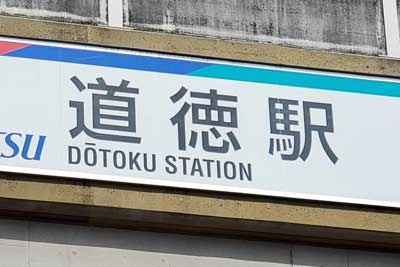2022.05.25

Travellers on the Meitetsu Tokoname Line who find themselves on a local (stopping-all-stations) train may be surprised to find a station with the name Dōtoku (道徳).
道徳
dōtoku (morals)
Also found in 道徳教育 / dōtoku kyōiku (moral education), (非)道徳的 / (hi-) dōtoku-teki ([im-] moral; [un-] ethical)
道 dō, also michi (path; way; road)
+
徳 toku (virtue; benevolence)
From the name, one might assume a connection to religion or philosophy that has made outstanding virtue a point of local pride. But the origin of the name can be traced to efforts to divert the flow of the Tempaku River in the 18th century. A number of farmers displaced by the diversion were relocated to a section of reclaimed land known as Okaechi Shinden (御替地新田, lit. replacement new rice field), which had been developed at the expense of the Owari domain authorities.
When agricultural administrator Higuchi Yoshifuru (樋口好古) visited in 1812 and heard the history of the area's development, he is said to have been moved by this exemplary realization of the Owari Tokugawa clan policy of the application of benevolence with moral principles (dōgi o motte toku o hodokosu / 道義を以って徳を施す). Borrowing the characters 道 (dō) and 徳 (toku) from this phrase, the Okaechi Shinden was renamed Dōtoku Shinden (道徳新田).
Much of Dōtoku Shinden has now been renamed Toyoda (豊田, lit. plentiful rice field); the area now referred to as Dōtoku, west of the Meitetsu Tokoname Line, is actually another section of reclaimed land once known as Dōtoku-mae Shinden (道徳前新田) which adjoined Dōtoku Shinden. Sold by the Tokugawa family in 1925, Dotoku-mae Shinden was developed as a residential area by the Nagoya Wharf Warehouse Company. A number of leisure attractions were also developed, including Dōtoku Kannon-yama (道徳観音山), an 18-meter-high concrete mountain with a 2-meter statue of the bodhisattva Kannon enshrined on its peak (later replaced with a 6-meter version), a waterfall and pool, and an ice-skating rink inside. Restaurants, cafes, milk halls, geisha houses and a hot spring resort made the area one of Nagoya's popular leisure spots in the early Showa period.

Dōtoku Kannon waterfall and pool, 1932
Dōtoku Park's concrete whale fountain, dating from the park's opening in 1927 and designated a National Tangible Cultural Asset in 2021, is one of the few existing remnants of this period.




